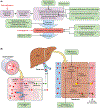Management of Acute Coronary Syndrome in the Older Adult Population: A Scientific Statement From the American Heart Association
- PMID: 36503287
- PMCID: PMC10312228
- DOI: 10.1161/CIR.0000000000001112
Management of Acute Coronary Syndrome in the Older Adult Population: A Scientific Statement From the American Heart Association
Abstract
Diagnostic and therapeutic advances during the past decades have substantially improved health outcomes for patients with acute coronary syndrome. Both age-related physiological changes and accumulated cardiovascular risk factors increase the susceptibility to acute coronary syndrome over a lifetime. Compared with younger patients, outcomes for acute coronary syndrome in the large and growing demographic of older adults are relatively worse. Increased atherosclerotic plaque burden and complexity of anatomic disease, compounded by age-related cardiovascular and noncardiovascular comorbid conditions, contribute to the worse prognosis observed in older individuals. Geriatric syndromes, including frailty, multimorbidity, impaired cognitive and physical function, polypharmacy, and other complexities of care, can undermine the therapeutic efficacy of guidelines-based treatments and the resiliency of older adults to survive and recover, as well. In this American Heart Association scientific statement, we (1) review age-related physiological changes that predispose to acute coronary syndrome and management complexity; (2) describe the influence of commonly encountered geriatric syndromes on cardiovascular disease outcomes; and (3) recommend age-appropriate and guideline-concordant revascularization and acute coronary syndrome management strategies, including transitions of care, the use of cardiac rehabilitation, palliative care services, and holistic approaches. The primacy of individualized risk assessment and patient-centered care decision-making is highlighted throughout.
Keywords: AHA Scientific Statements; acute coronary syndrome; cardiovascular diseases; frailty; geriatric assessment; multimorbidity; polypharmacy.
Figures




References
-
- Tsao CW, Aday AW, Almarzooq ZI, Alonso A, Beaton AZ, Bittencourt MS, Boehme AK, Buxton AE, Carson AP, Commodore-Mensah Y, et al. Heart Disease and Stroke Statistics-2022 Update: A Report From the American Heart Association. Circulation. 2022;145:e153–e639. - PubMed
-
- De Luca L, Marini M, Gonzini L, Boccanelli A, Casella G, Chiarella F, De Servi S, Di Chiara A, Di Pasquale G, Olivari Z, et al. Contemporary Trends and Age-Specific Sex Differences in Management and Outcome for Patients With ST-Segment Elevation Myocardial Infarction. J Am Heart Assoc. 2016;5. - PMC - PubMed
-
- De Luca L, Olivari Z, Bolognese L, Lucci D, Gonzini L, Di Chiara A, Casella G, Chiarella F, Boccanelli A, Di Pasquale G, et al. A decade of changes in clinical characteristics and management of elderly patients with non-ST elevation myocardial infarction admitted in Italian cardiac care units. Open Heart. 2014;1:e000148. - PMC - PubMed
-
- Zaman MJ, Stirling S, Shepstone L, Ryding A, Flather M, Bachmann M and Myint PK. The association between older age and receipt of care and outcomes in patients with acute coronary syndromes: a cohort study of the Myocardial Ischaemia National Audit Project (MINAP). Eur Heart J. 2014;35:1551–8. - PubMed
-
- O’Neill DE and Forman DE. Cardiovascular care of older adults. BMJ. 2021;374:n1593. - PubMed
Publication types
MeSH terms
Grants and funding
LinkOut - more resources
Full Text Sources
Miscellaneous

